Jerusalem is a great city to discover by foot. A good time to do this is Saturday morning when much of the busy traffic from weekdays is absent for Shabbat. Yesterday morning I spent a couple of hours strolling the area around Jaffa Street - one of Jerusalem's main thoroughfares. It is especially pleasant to walk on Jaffa Street at the weekend these days as since the inauguration of the light railway, cars are prohibited from some stretches.
This part of the city has seen much history and bears many reminders of the the past. Some of these are physical such as the many blue plaques that attest to former important and famous residents or to significant events that took place here. Many were during the period of the British Mandate from 1922 - 1948 when the British were in control. Several of the plaques commemorate incidents that took place during the struggle for independence. More dramatic reminders of this period include the bullet holes still visible in the original Jerusalem Municipality building at number 10 Saffra Square (pictured below), adjacent to Jaffa Street. This building is located at the meeting point between the eastern and western parts of the city and the ground floor was once the home of Barclays Bank. The metal work on the front of the building still carries the Barclays "BB" logo to attest to this.
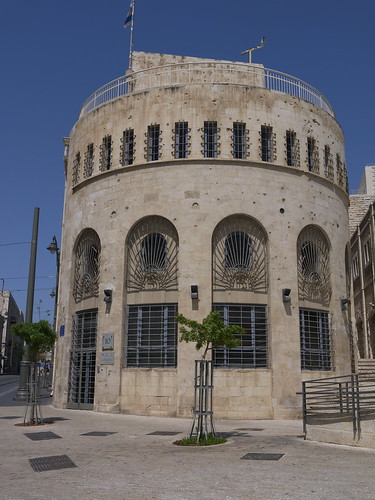

There are also reminders of an earlier period in and around Jaffa Street. Before the British arrived in 1917 towards the end of the First World War, the Ottoman Turks had held sway. A number of buildings remain that show reference to this period. One of my favourites is in Helene Ha-Malka Street. Pictured below, this apartment building has beautiful Ottoman style ceramic details around the windows, openings to the balcony and upper levels in classic blue and white vegetal designs. Whilst taking the photograph below and admiring the ceramic details, two passers-by stopped to see what I was so interested in. In one of those chance but rich moments that travellers often have, I became engaged in a short conversation with this couple about the building and about how we often don't see things if we pass them every day. They took a photo of this little gem before moving on!
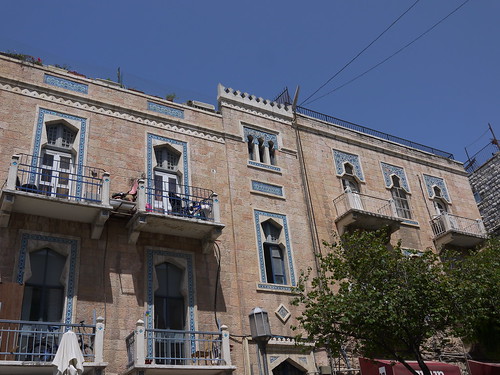
Tel Aviv is world famous for its wonderful collection of Bauhaus buildings. But I wonder how many readers realise that Jerusalem also boasts many outstanding examples of this architectural style, several of which are a short step from Jaffa Street. One of my favourites is the Makower House at 8 Shmuel Ha-Nagid Street (pictured below). Real estate investor Mr. Makower commissioned architects Alexander Friedman and Meir Rubin to design an upmarket apartment block at the junction of Bezalel and Shmuel Ha-Nagid streets. The block is extremely dynamic with large rounded balconies, convex and concave elements and a stairwell enclosed with a glass box ladder. These two architects designed many important buildings in Jerusalem including the Yeshurun synagogue a little further along the same street, completing that project in 1936, two years before commencing on the Makower House which was completed in 1939.
Back on Jaffa Street itself, is the gloriously curved number 34 (pictured below), built some time around 1935 as a business complex. Unfortunately the architect is unknown (unless of course you have information - please post a comment if you do!). This three storey building occupies a large site along Jaffa Street and a small segment of Helene Ha-Malka street. The ground floor is occupied by shops with significant glass frontage enabling the traders to display their wares to passers by. The upper levels have much smaller windows slightly recessed and are framed by ledges and cornices that provide shade. It is thought that the Russian Patriarchate commissioned this building, evidence of this being the Patriarchate's signet at the upper level on that delicious curve. Speaking of delicious, you can get coffee downstairs at Coffee Bean, although I must admit I am a Cafe Hillel man myself - and there is a branch on the opposite corner!
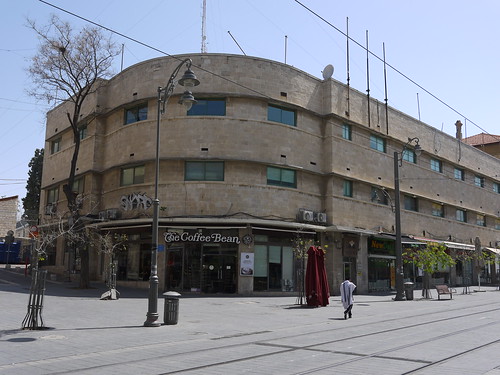
To avoid a detour into cafes, coffee and cakes, let's move on to another less well known dimension of this most surprising of cities. Some readers will be aware of Israel's large Ethiopian Jewish community and possibly of how they came to be here, rescued from danger in Africa in two major operations. However, there has long been a Christian connection between Ethiopia and Eretz Israel and this again can be seen in Jerusalem's built heritage. On my Saturday morning walk, I veered away from Jaffa Street, past Heshin Street's Russian Orthodox Church with its onion domes, along Shivtei Israel and into Hanev'im Street which is home to a spectacularly decorated building that houses the Ethiopian Consulate at numbers 38-40. This building has seen better days but still carries the Lion of Judah, Amharic inscriptions and Ethiopian decorations about the facade's windows. Built between 1925 and 1928 for the Empress Zewditu, she never actually lived here. She was a remarkable woman, the first female head of state in Africa in the 20th century, ruling from 1916 -1930, enabling reforms but suffering from many political intrigues within her court. She died of diabetes in 1930 although there is some conjecture about the circumstances of her death.
Continuing with the Ethiopian connection, I proceeded along Hanev'im Street turning right into the aptly named Ethiopia Street which is home to another of Jerusalem's secret treasures - the Ethiopian Church. This large circular structure, completed in 1893, is accessed through a narrow doorway, with Amharic scriptures overhead, into a pleasant courtyard. The exterior of the building is undecorated but imposing due to its size and circular shape. However, the interior is a riot of colour and decoration with pinks, blues and greens on the walls, ceilings and dome. There are also many icons of saints important to the Ethiopian Church and Amharic scriptures throughout the building. The interior is cool, quiet and peaceful and apart from a gently napping cleric, I had the whole place to myself. The picture below gives a hint of the beauty of the interior.
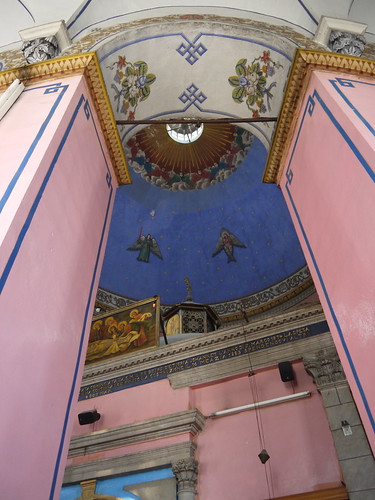
The final stop on my walk is a ten minute stroll, back onto Hanv'im Street, along King George Street, crossing Jaffa and Ben Yehuda Streets until reaching the Old Bezalel Building at 10-12 Shmuel Ha-Nagid Street, close to that lovely Bauhaus building. I have written before about the Bezalel School for the study of fine arts, its founders Ze'ev Raban and Boris Schatz and its continuing legacy. Today the building acts as the Artists' House, hosting exhibitions of contemporary art as well as being a sales gallery. The House is open on Shabbat and I spent an enjoyable thirty minutes chatting with the helpful and interesting lady in the gallery who told me about the sculptures of Aharon Bezalel, a Jew born in Herut, Afghanistan and who came to Eretz Israel in 1938. His bronzes are exquisite - but a little out of my price bracket!
The building dates from the Ottoman period whilst a few items from the original Bezalel School can be seen in the lobby, including doors designed by Raban. There are also some interesting carvings on the pillars at the foot of the steps leading to the entrance and the building is known for the large menorah on its roof - pictured below.
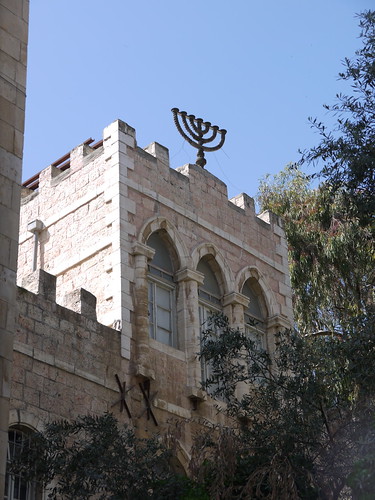
Oh yes, and just across the road from the Artists' House there is a nice looking cafe. It is closed on Shabbat so I didn't get to sample its delights, but I swear it was fluttering its eyelashes at me - just look at those shutters! I sense a theme emerging since I had a similar architectural experience in Tel Aviv. No doubt its a sign that if you treat the city nicely, many more secrets will unfold.


No comments:
Post a Comment